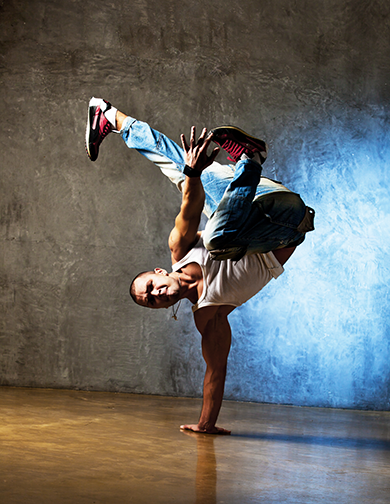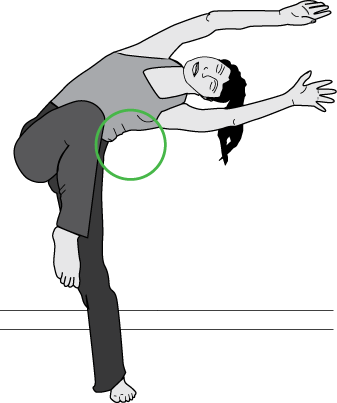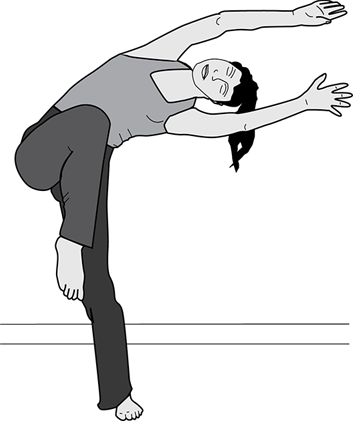Study Guide
Field 164: Dance
Recommendation for individuals using a screenreader: please set your punctuation settings to "most."
Sample Selected-Response Questions
Competency 0001
Creating
1. In the development of a dance work, the principles of design are used primarily for which purpose?
- choosing a style or genre for the dance that enhances its creative expression or meaning
- creating sets and costumes that reflect the theme and support the intent of the dance
- providing a framework for arranging the movement elements and aesthetic qualities of the dance
- contributing movement elements that provide visual appeal and engage viewers
- Enter to expand or collapse answer. Answer expanded
- Correct Response: C. This item requires the candidate to identify and apply basic vocabulary and concepts related to generating choreography (e.g., motif, movement phrase, transitions, energy, pathways, contrast, group formations, principles of design). Principles of design, such as rhythm, structure, and space, are critical components of how dances are made. They provide a framework for ideas that connect movement elements with aesthetic goals.
Competency 0001
Creating
2. Which question would be most important for a choreographer to consider when using multimedia technologies to enhance the design and performance of a dance?
- Can the audience clearly distinguish between the virtual and real elements of the performance?
- Will the combination of technology and dancers result in aesthetic forms that are familiar to the audience?
- Does the use of technology support the aesthetic integrity of the dance as a work of art?
- Could the contrasting kinesthetic effects of three-dimensional bodies and flat imagery confuse the audience?
- Enter to expand or collapse answer. Answer expanded
- Correct Response: C. This item requires the candidate to demonstrate familiarity with the use of technology and media arts in choreographic processes and in creating and refining dance pieces (e.g., tablets and mobile devices, Web-based modalities, character animation software, interactive projection). Technology has been incorporated into dance for decades. Its use generally supports the aesthetic integrity of the dance and enhance meaning, rather than be used for its own sake.
Competency 0002
Performing
3. Use the photograph1 below to answer the question that follows.

A man wearing a t-shirt, jeans, and sneakers is caught in motion with his right arm supporting the entire weight of his body. His left arm is also straight and points upward, with the fingers on his left hand open. His waist is above the level of his head, which is parallel to the ground. His left leg is bolt straight and high above his head. His right leg is bent at the knee. It is also above his head. The floor is brown. The background wall is gray with a light blue section due to off-camera lighting.
The body shape presented in this photograph could best be described using which list of dance-elements vocabulary?
- axial, low level, angular
- narrow, heavy, curved
- middle level, asymmetrical, balanced
- bound, unbalanced, suspended
- Enter to expand or collapse answer. Answer expanded
- Correct Response: C. This item requires the candidate to demonstrate and apply knowledge of basic vocabulary and concepts related to learning, performing, refining, and responding to dance and dance movement (e.g., locomotor/axial alignment, center of gravity, symmetry/asymmetry, momentum, dynamics, musicality). In dance, middle level refers to a dancer who is supported by the floor but not standing in an upright position. Asymmetrical refers to shape that is different on the right side and left side of the body. Balance refers to stability, base of support, and the dancer maintaining center of gravity. The dancer shown exhibits all three qualities.
Competency 0002
Performing
4. In a dance-class activity, students work in pairs. One partner creates a body shape and the second partner creates a shape that relates to the first partner's shape, fitting into it like a puzzle piece without touching the partner. The second partner holds that pose and the first moves out of the first pose to create a new shape that relates to and fits into the shape of the second partner's pose. As the partners continue taking turns in this way, the dancers are exploring primarily which concept related to the elements of dance?
- the creation of texture and dynamics in movement
- qualities related to focus and range in space
- variations within flow and pathway of movement
- relationships between positive and negative space
- Enter to expand or collapse answer. Answer expanded
- Correct Response: D. This item requires the candidate to demonstrate and apply knowledge of the dance element of space in learning, performing, refining, and responding to dance. In dance as in visual art, positive space refers to the main subject and negative space is all other empty space. In this case, the first dancer occupies positive space with a body shape and the partner creates a shape filling in the negative space created by the first dancer. The first dancer then moves out of the pose, making the second dancerís pose the positive space. Each time they move out of and into new poses in this manner they are exploring relationships between positive and negative space.
Competency 0002
Performing
[On an actual exam, the examinee will see the following directions and will have the ability to click anywhere on the image. A bullseye will appear on the spot where the examinee clicks. In this study guide, the examinee can click anywhere on the image. A bullseye will appear in the region where the examinee clicks, but not the exact spot on which the examinee clicks. In the actual exam, the examinee may change the location of the bullseye by clicking elsewhere on the image until they are satisfied with their choice.]
5. Directions: Examine the illustration below of a moment in a dance. Click on the region where the dancer's center of gravity is located.
A female dancer balancing on her left leg. Her right leg is bent at the knee and raised up with the knee cap above the waist. Her torso is almost perpendicular to the ground as she stretches her arms straight out above her head and leans to the left. Her left leg is straight, her left foot the only contact with the floor.
- Enter to expand or collapse answer. Answer expanded
-
Correct Response: Area immediately outside the dancerís left hip.

A female dancer balancing on her left leg. Her right leg is bent at the knee and raised up with the knee cap above the waist. Her torso is almost perpendicular to the ground as she stretches her arms straight out above her head and leans to the left. Her left leg is straight, her left foot the only contact with the floor. The area immediately outside the dancerís left hip is marked with a target, indicating it as the chosen response.
This item requires the candidate to demonstrate and apply knowledge of basic vocabulary and concepts related to learning, performing, refining, and responding to dance and dance movement (e.g., locomotor/axial alignment, center of gravity, symmetry/asymmetry, momentum, dynamics, musicality). Center of gravity is the point or area where an object or, in this case, a person, is balanced. The dancerís pose shifts weight from the waist up through the torso, arms, and head to the dancerís left. Counterbalancing weight comes from the waist down through the legs, including the raised and bent right leg, which makes the center of gravity roughly the small space just to the left of the dancerís left hip.
Competency 0003
Responding
6. At the beginning of a duet, the dancers enter from opposite sides of the stage, keeping their focus outward. Then, they shift focus toward each other, as if appearing to notice each other for the first time. With large movements and high energy, they move to meet at center stage. As soon as they come together, the dancers transition to small, delicate movements and soft gestures as they dance around and with each other. After the dancers meet, what do the choreographic choices most convey?
- a variety of moods that stimulates audience interest in the dance
- a sense of intimacy between the two characters the dancers portray
- an overall impression of balance in the choreography
- a moment of climax and a feeling of excitement
- Enter to expand or collapse answer. Answer expanded
- Correct Response: B. This item requires the candidate to recognize and analyze ways in which various components of a dance performance can create and communicate meaning in a dance work (e.g., dance elements; choreographic design; use of props, costumes, multimedia, and staging; accompaniment; venue; lighting; context). A strong sense of intimacy is conveyed by the dancersí actions as they move from large movements to smaller movements towards each other.
Competency 0003
Responding
7. A choreographer is likely to choose to record a dance piece by using motif notation, rather than Labanotation, if the choreographer's primary concern is to:
- document the material verbally rather than symbolically.
- create a literal, detailed description of each element of movement.
- convey the overall structure and intent for dancers to interpret.
- provide a visual record of movement ideas and order.
- Enter to expand or collapse answer. Answer expanded
- Correct Response: D. This item requires the candidate to demonstrate and apply knowledge of various systems used to record and document dance movement and performance (e.g., dance notation, motif writing, technology). Labanotation and motif notation are both notation systems that capture movement using symbols. Labanotation maps every detailed movement of a given sequence to be duplicated exactly. Motif notation captures the order, overall structure, and essential elements of the movement.
Competency 0004
Connecting
8. Which aesthetic characteristics are more likely to appear in a contemporary ballet than in a classical ballet?
- high leg extensions, lengthened fingers, curved arm shapes, and asymmetrical poses
- pantomime, character dancing, and use of the corps de ballet
- turned-in legs, angular arm shapes, floor work, and a greater range of upper-body movement
- elaborate scenic designs, narrative structure, and orchestral music
- Enter to expand or collapse answer. Answer expanded
- Correct Response: C. This item requires the candidate to demonstrate and apply knowledge of distinguishing aesthetic characteristics, techniques, and movement patterns of various genres and styles of major concert and theatrical performance dances and traditional and social participatory dances worldwide. The essential difference between classical ballet and contemporary ballet is that the former has codified rules and the latter does not. Turned-in legs, angular arm shapes, floor work, and a great range of upper body movement move away from the codified realm of classical ballet.
Competency 0004
Connecting
9. In many countries, arts organizations train dancers and present staged, choreographed public performances based on traditional dances of indigenous peoples, such as folk dances in Mexico, court dance-dramas in Cambodia, and ceremonial dances in Senegal. This approach to the performance of traditional dance forms is most likely to function in which way within present-day societies?
- preserving and reinforcing the unique historical and cultural identity of a society
- encouraging development of new aesthetic perspectives and values within a society
- providing recognition of significant dance artists and the contributions of the arts to the society
- reflecting contemporary developments in a society through the creation of new dance forms
- Enter to expand or collapse answer. Answer expanded
- Correct Response: A. This item requires the candidate to identify and analyze the aesthetic, social, and cultural functions of dance within various cultures in past and present societies (e.g., recreation, entertainment, social expression, demonstrating group identity, ritual) and how dance styles and works, movement principles, techniques, and aesthetic criteria reflect the social, cultural, economic, and historical contexts from which they emerge (e.g., expressions of cultural values, beliefs, or historical trends; social commentary; gender roles and identity). Dance has always been a reflection of the societies from which it comes. Folk dances around the world, in particular, capture the customs of particular groups of people. Training dancers to perform traditional dances of indigenous peoples is a way to save those dance traditions from cultural extinction.
Acknowledgments
1RUSOTURISTO. Dancer Posing. Credit Line: RUSOTURISTO. Shutterstock. Copyright: © RUSOTURISTO

